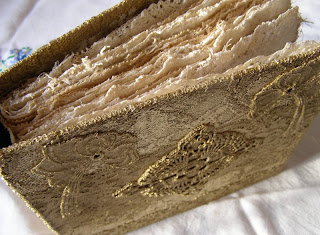Whan I posted about my brownies last week I had a request from Virginia to share the recipe, which I am happy to do:
Double Chocolate Brownies3oz butter
3/4 cup sugar
2 tablespoons water
2 cups chocolate chips
2 eggs (beaten)
1 teaspoon vanilla extract
3/4 cup plain flour
1/4 teaspoon baking powder
In a saucepan, melt together the water, butter and sugar, bringing to the boil. Remove from the heat and stir in 1 cup of the chocolate chips until melted and smooth. Allow to cool slightly and beat in the eggs and vanilla. Sift flour and baking powder together and stir into the chocolate mixture. Stir in the remaining chocolate chips. Pour mixture into a greased and lined 9 inch (23 cm) square tin and bake for 30 - 35 mins at 170 deg C. Cool in tin, turn out and cut into 16 squares.

This is the recipe I discovered when living in the US, it always works and is one that I have used faithfully for the past 24 years. But every so often I like to be unfaithful... and then I turn to Nigella again and make a huge decadent pile of her
brownies, laced with walnuts and white chocolate. After some extensive tasting this week, I have decided this is the recipe I prefer.

On a completely different note, after reading
this post from Alice, I decided to investigate and as a result I heard yesterday that my blog has also been selected by the British Library to be included in its
UK Web Archive. It will be available for the future to represent aspects of UK documentry heritage, available to researchers and anyone who might be interested. This is hugely exciting for me and for a while I was worried that perhaps my blog should assume a weightier tone, providing an intelligent, witty, erudite and insightful view of British life today... but then common sense prevailed and I realised I would probably just continue with frequent photographs of cakes.
It did prompt some thinking on the nature of blogging though. Although my initial reason to blog was to document my degree course it soon became apparent that was not the complete story. If that was all it was, then I could just as easily keep a private journal but blogging is a public endeavour which requires an audience. There is very little point without readers and commentors and as ever I am always grateful to everyone who takes the time to read and/or comment, whether regularly or occasionally. For that I thank you. One new
commentor on my blog has written about this far more eloquently than me, and you can read his thoughts
here. As for me... I think I'll stick to cake!
 Initial visual research led me to the conclusion that gender differences are arbitrary, socially constructed. The textile acquires masculine or feminine traits through association. Lace has feminine associations in both dress and the domestic environment yet has been worn by both sexes throughout history.
Initial visual research led me to the conclusion that gender differences are arbitrary, socially constructed. The textile acquires masculine or feminine traits through association. Lace has feminine associations in both dress and the domestic environment yet has been worn by both sexes throughout history. I was particularly struck by the similarities of the feminine lace petticoats that form part of traditional Mexican dress and the lace garment worn as part of papal vestments. Lace is a textile of strong contrasts; masculine and feminine, delicate yet strong, demure yet erotic... revealing and also concealing.
I was particularly struck by the similarities of the feminine lace petticoats that form part of traditional Mexican dress and the lace garment worn as part of papal vestments. Lace is a textile of strong contrasts; masculine and feminine, delicate yet strong, demure yet erotic... revealing and also concealing. The holes in the lace are a metaphor for the missing parts of stories, the gaps in our knowledge. The idea of looking through holes to see deeper layers led to the idea of pages in a book. The book is a powerful communicator, inviting conversation with the spectator.
The holes in the lace are a metaphor for the missing parts of stories, the gaps in our knowledge. The idea of looking through holes to see deeper layers led to the idea of pages in a book. The book is a powerful communicator, inviting conversation with the spectator. Book pages were constructed from pieces of donated lace, each piece bringing with it a story, a history, yet in each case an incomplete story with parts missing. As I stitched the lace together, stories were stitched into the surface becomming embedded within the pages, present yet hidden, revealed yet concealed.
Book pages were constructed from pieces of donated lace, each piece bringing with it a story, a history, yet in each case an incomplete story with parts missing. As I stitched the lace together, stories were stitched into the surface becomming embedded within the pages, present yet hidden, revealed yet concealed. The narrative becomes the thread that holds the story together. The spectator is invited to fill in the missing pieces, the holes, the lacunae. Nothing is obvious.
The narrative becomes the thread that holds the story together. The spectator is invited to fill in the missing pieces, the holes, the lacunae. Nothing is obvious.













































